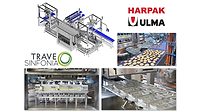Packaging Machinery
Harpak-ULMA Introduces Tray Sealer

Image courtesy of Harpak-ULMA
Harpak-ULMA has introduced the Mondini Trave Sinfonia, which is designed to enable snack and meal producers to increase packaging throughput in a smaller more flexible footprint with reduced labor requirements. Producers can automate tray packaging processes with control of the product loading (positional accuracy within 10 microns), sealing and unloading process. This process is combined with Mondini’s new sealer—its largest sealer to date—a 1500mm long tooling footprint that delivers 33,000 lbs. of sealing pressure. The new Mondini sealer is integrated with the electronically controlled magnetic track system. It allows the Trave Sinfonia to achieve tray throughput and efficiency in a compact form factor that requires less manual interaction, according to the company
The magnetic rail carries independent trolleys, known as nests. Each nest acts as the bottom sealing tool, eliminating the need to remove the package from the nest to seal it. A programmable software interface makes it easy to customize control with accuracy for each individual shuttle, the company says. Unlike mechanical systems, which rely on pusher arms, conveyors vision systems, or sensors to index tray placement, this digital system delivers control of each tray's position, velocity and acceleration electronically. The company claims that this increased level of control is what optimizes the tray sealing process, delivering efficiency and adaptability through tray movement customization. In addition, traditional infeed and outfeed belts are eliminated— along with associated guides, pacers, belts and pusher arms, transition points as well as the associated floor space. The result is reportedly a frictionless transfer contributing to individual tray control during packaging while simplifying maintenance.
"The ability to optimize each aspect of the packaging process individually while increasing control – along with reduced machine complexity and footprint – is unique," says Carlo Bergonzi, Tray Seal manager at Harpak-ULMA. "In a typical packaging line, the slowest or least efficient point dictates line speed and efficiency. In this case such constraints do not gate an individual nest. The new system is a huge efficiency boost to automated loading as each nest can move independently to whatever loading station is needed. In another example, we can load intermittently at one depositor and continuously at another. It’s a very flexible system.”
Looking for a reprint of this article?
From high-res PDFs to custom plaques, order your copy today!





